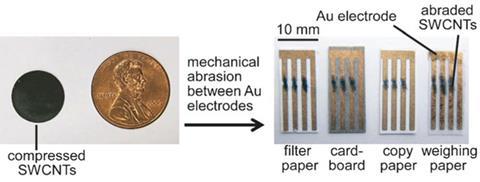Simple way to make paper-based gas sensors could be used to detect almost any gas or disease biomarkers

US researchers have literally put pencil to paper and created a gas sensor that can detect ammonia as well as existing sensors. The ‘pencil’ comes in the form of a carbon nanotube (CNT) disk which was used to draw on paper patterned with metal electrodes to create the sensor. The team says their work offers a simple and cheap way to create sensors that could potentially detect almost any gas including disease biomarkers in exhaled air and chemical warfare agents.
CNTs have been used to make sensors before but methods typically rely on solution-phase processing. This poses limitations because CNTs have very low solubility in most liquids and therefore methods that use solutions of CNTs are complex and expensive requiring toxic organic solvents, surfactants and prolonged sonication, which can cause structural damage to the CNTs.
Now, Katherine Mirica and colleagues at Timothy Swager’s lab at the Massachusetts Institute of Technology, Cambridge, US, have developed a simple, solvent-free approach for fabricating ammonia gas sensors using single-walled CNTs and paper. ‘The method is really as simple as drawing with pencil on paper. It requires no specialised facilities such as a clean room or highly trained technicians to carry out the fabrication process,’ says Mirica.
The team made their sensors by first creating a pencil lead from CNTs by compressing commercially available CNT powder using a press. They then deposited gold electrodes on the surface of different kinds of paper and used the CNT pencil to fill in the gaps between the electrodes.
To test them they flowed ammonia gas diluted with nitrogen past the sensors and measured the corresponding electrical current that flowed through the nanotubes during exposure to ammonia. It works because all the CNT atoms are located on the material’s surface, which means the presence of the ammonia affects the amount of current flowing through the nanotubes. This change in current correlates with the amount of ammonia that the nanotubes are exposed to.
‘We were very surprised by the excellent sensitivity of our sensors towards ammonia, and by the excellent sensor-to-sensor reproducibility,’ says Mirica. They found that CNTs drawn on papers with a smooth surface result in better sensors than those drawn on papers with a rough surface. ‘Through specific functionalisation of carbon nanotubes, this technology has the potential to be adapted to detect almost any type of gas.’
‘This is an idea that is very elegant in its simplicity – it combines the high surface area and chemical sensitivity of carbon nanotubes, an admirably straightforward method of using them, and a very inexpensive support to make a new type of sensor that has both good sensitivity and the potential for low cost,’ comments George Whitesides at Harvard University, Cambridge, US. ‘This combination circumvents a number of the limitations in high-technology and highly expensive fabrication that have made it impractical to take advantage of the useful characteristics of carbon nanotubes as sensors in the past.’












No comments yet